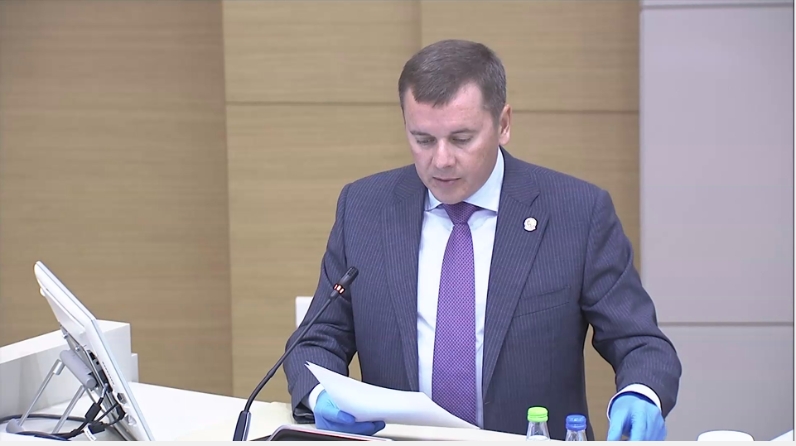In Tatarstan, 206 thousand hectares, or 13.7% of the plan, were threshed, the average yield is 40.7 centners / ha

In the Republic of Tatarstan, 1.5 million hectares of grain and leguminous crops have to be harvested, including: winter wheat - 361 thousand hectares, winter rye - 110 thousand hectares, spring wheat - 413 thousand hectares, barley - 468 thousand hectares, peas - 60 thousand hectares.
Such data was presented today at a meeting in the Government House of the Republic of Tatarstan by the Deputy Prime Minister of the Republic of Tatarstan - Minister of Agriculture and Food of the Republic of Tatarstan Marat Zyabbarov.
The Prime Minister of the Republic of Tatarstan Alexey Pesoshin held a videoconference meeting with all municipal districts.
The head of the Ministry of Agriculture of the Republic of Tatarstan also noted that the harvesting of 231 thousand hectares of oilseeds (rape and sunflower) is to be done.
“We will have to carry out harvesting work with the existing 3.5 thousand combines with an average load of about 413 hectares on a combine,” the minister said.
Today in the republic: 206 thousand hectares have been threshed (for comparison: 87 thousand hectares in 2019), or 13.7% of the plan, 836 thousand tons of grain have been threshed (+ 547 thousand tons by 2019), the average yield is 40.7 c / ha (32.7 c / ha in 2019).
So far, the highest yield of winter wheat is over 44.2 c / ha, with a harvest of 541 thousand tons.
For peas today, the yield is with 3.6 c / ha, or 27.5 c / ha more than last year.
“In general, all the districts are set to clean up, but at the start, the districts worked differently. For greater objectivity, I will give the rate of harvesting in 4 climatic zones, ”the minister said.
There are 8 municipal districts in the Predvolzhskaya zone. Among them, the highest rate was in Buinsky district - 25% of grain was harvested with an average yield of 40.6 c / ha, Drozhzhanovsky - 21%, yield - 38.6 c / ha, Apastovsky - 20%, yield - 34.6 c / ha, Verkhne-Uslonsky and Kamsko-Ustinsky districts harvested only 11% of crops each.
Western Zakamye (7 districts): Nurlatsky district has 26% of harvested areas with a yield of 42.5 c / ha, at the same time Chistopolsky harvested only 12% of the areas; Alekseevsky district harvested 19% of crops, its neighbor Novosheshminsky is even less - only 10%.
Eastern Trans-Kama region (7 districts): Zainsky district harvested 25%, the yield is over 62 c / ha. Other neighbors are still seriously lagging behind.
South-Eastern Zakamye (7 districts): Aznakayevsky district has a high rate - 20%, yield - 46 centners / ha, Cheremshansky and Yutazinsky districts have removed 14% each. The rest of this zone has less than 10% of harvest.
“For objective reasons, our northern regions will start mass cleaning next week. At the same time, several agricultural enterprises have not yet completed the repair of their combines. I ask the heads of these farms to take exhaustive measures”, said Marat Zyabbarov.
To accelerate the pace, you should use the services of elevators, said the head of the Ministry of Agriculture of the Republic of Tatarstan. The grain drying complexes of these enterprises are capable of drying more than 90 thousand tons of grain per day (3.9 thousand tons per hour). All of them are ready to receive grain from the new harvest. “Highly productive work at all sections of the harvesting conveyor largely depends on the successful application of employee incentive methods. This year, we are announcing a republican competition of combine operators for a grant from the President of the Republic of Tatarstan, 200 prizes of 100 thousand rubles each have been established. I ask the districts to objectively keep records of the work of combines and provide information to the Ministry of Agriculture of the Republic of Tatarstan in a timely manner, ”the minister said.
Marat Zyabbarov reported on the African swine fever (ASF) situation. According to him, the situation in the Russian Federation remains tense.
Today, there are 30 outbreaks of quarantine for ASF, including 15 cases in the Samara region, 3 in the Nizhny Novgorod region. Of particular concern are outbreaks in the Samara region, since they are at a distance of about 100 kilometers from the Cheremshansk and Nurlatskiy regions.
Marat Zyabbarov noted that the main reasons for the spread in the Samara region are the neglect of ASF prevention measures by pig owners and the circulation of the virus among wild boars.
According to him, the State Committee of the Republic of Tatarstan on biological resources must strictly monitor the number of wild boars and take all measures to prevent the migration of wild boars from problematic regions of Russia.